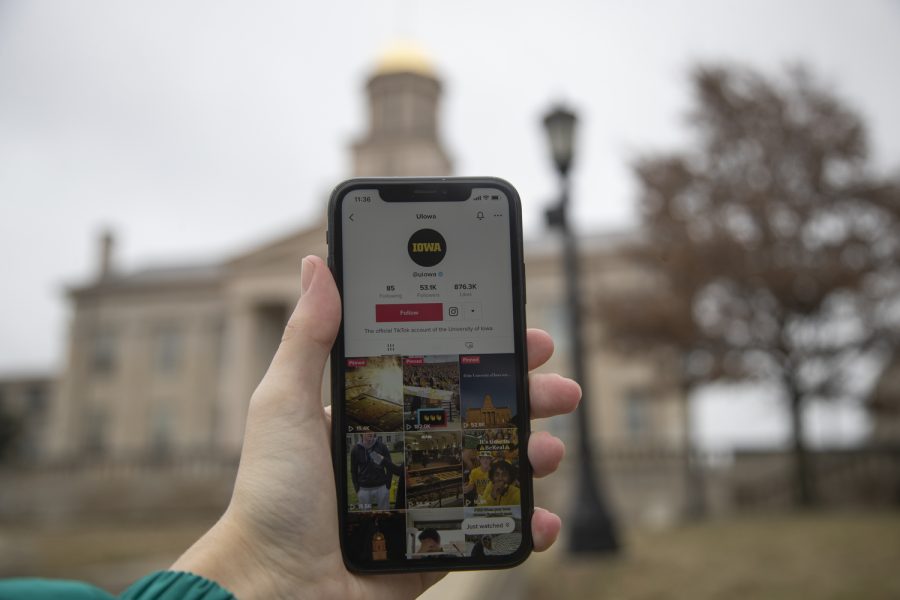Opinion | UI should ban TikTok on networks
As universities across the U.S. ban TikTok from their wifi servers, UI should follow suit.
University of Iowa TikTok page outside Old Capitol Building in downtown Iowa City Thursday, Jan. 19, 2023.
February 6, 2023
TikTok has maintained a grip on users since 2016, and it is time for the app to be decommissioned from University of Iowa networks.
Several colleges have recently banned TikTok from their networks, including Boise State University, Morgan State University and University of Oklahoma. Many other states enacted different policies, with a majority banning the app on state devices.
The UI removed and prohibited the installation of TikTok across University-owned devices. This comes after Regents President Mike Richards directed the regent schools to ban TikTok from institution-owned devices in a statement. The official UI TikTok account was also shut down.
TikTok has been under fire for their methodology of gathering data. Consumer Reports, a U.S. nonprofit consumer organization, revealed that programs used in data-gathering work on mobile devices even when not being used.
“TikTok, one of the country’s most popular apps, is partnering with a growing number of other companies to hoover up data about people as they travel across the internet,” noted Consumer Reports. “That includes people who don’t have TikTok accounts.”
The Federal Communications Commission declared TikTok a risk to national security. Brendan Carr, commissioner of the FCC, cites the app’s Chinese origination as problematic concerning the access of information from U.S. users.
“TikTok poses an unacceptable national security risk due to its extensive data harvesting being combined with Beijing’s apparently unchecked access to that sensitive data,” Carr stated in a June 2022 letter which encouraged Apple and Google to take the app off of the store.
Others will say that TikTok exacerbates mental conditions. One particular example reported by The Science Times shows an increase of tics in teens and children, correlating with viral videos of those with Tourette’s attempting challenges around their condition. It’s good that content is there, but the social debilitation possible on a wide scale is concerning.
For the older university students, TikTok is still problematic. According to a Wallaroo Media report, 29.5 percent of its user base is aged 20-29. Many face it as a distraction, which can impact grades.
A survey from OneClass has shown that screen time among undergraduates correlates with grades lower than a B-. It’s important to note that the survey was concerned with strictly non-educational uses of cellular devices.
Caitlynn Tran, a first year at the UI, describes how the app distracts her for long periods of time.
“TikTok [use] so far today has been three hours and 18 minutes,” Tran said.
It is not a new fact that social media platforms utilize hidden data-collection measures for profit. In 2020, Facebook’s user data — used for advertisements — was breached, failing to protect the personal information of up to 87 million people. This scandal is a symptom of social media usage across all platforms.
The adage goes in the tech industry: If you’re not paying for the product, you are the product.
What makes TikTok unique is how fast we accepted it. After taking over the once-popular Musical.ly, TikTok would eventually generate $4.6 billion in 2021. A 142 percent increase from the prior year, reports BusinessofApps.
In 2023, ad revenue for TikTok is expected to reach $18.04 billion, according to company Oberlo. There is no doubt there is lots of money to be made, and ByteDance won’t go down without a fight.
The UI should ban TikTok across its networks. Students can get easily distracted by the app’s short-form content, making procrastination periods reach hours. Alongside issues of personal privacy, these are the downsides and risks to TikTok as a platform. While the UI can’t track everyone’s phone, this network ban will discourage many from sinking their time into the app.
Columns reflect the opinions of the authors and are not necessarily those of the Editorial Board, The Daily Iowan, or other organizations in which the author may be involved.



